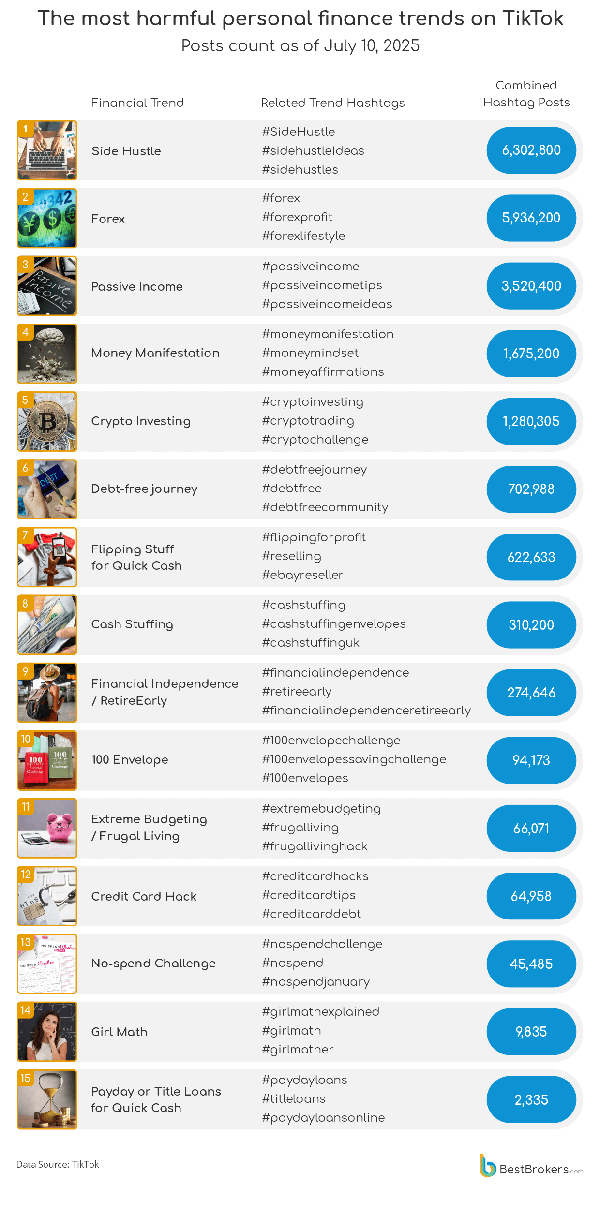Aug
2025
TikTok’s finance trends: Gen Z are ‘earning’ through manifestations, rituals, and extreme frugality
DIY Investor
26 August 2025
As the White House launches its official TikTok account, the likelihood of a U.S. ban on the platform appears to be fading, a relief for millions of American users. But what many of them are using the app for is leaving finance experts scratching their heads: learning how to ‘manifest’ wealth, perform money-attracting rituals, and adopt extreme frugality, all in pursuit of financial empowerment through viral trends. In light of this, I am sharing new research identifying the most misleading passive income trends currently going viral on the app.
To uncover which TikTok personal finance trends carry the greatest hidden risks, and to evaluate the reliability of much of the platform’s financial advice, the team at BestBrokers analysed trending hashtags and post counts, ranking 15 viral personal finance trends based on the number of posts using the three hashtags most commonly associated with the trend. For the most popular trends, the team conducted additional analysis of the top 10 most liked videos from the past six months. The full dataset, complete with links to the TikToks in question, is available on Google Drive here.
Alongside more familiar, but often misleading, hashtags like side hustles, forex trading, and passive income, TikTok has become a breeding ground for trends that blur the line between money management and magical thinking. Data shows that ‘money manifestation’ ranks as the fourth most misleading financial trend on the platform, with 1.7 million posts tied to its three most popular hashtags. Equally pervasive are extreme frugality movements such as the viral ‘no-spend challenges’, which together account for millions of views and likes.
In the second half of 2025, these trends have only deepened: TikTok creators are now promoting manifestation rituals tied to astrological dates, while a swelling ‘No-Buy 2025’ movement urges young Americans to reject consumerism altogether. To financial experts, it is a curious contradiction: Gen Z is embracing both spiritual shortcuts to wealth and ascetic pledges of radical frugality, two sides of the same digital coin.
Here are a few key takeaways from the research:
- The 10 most-liked money manifestation videos on TikTok have drawn over 25 million views and 3.5 million likes. One of the most popular clips, ‘Money is coming, new home is coming’ (4M views, 489K likes), claims prosperity can be spoken into existence, while steering users to a ‘digital income system’. Another hit, ‘I want a Mercedes’ (3.4M views, 390K likes), suggests luxury cars can be manifested, not purchased.
- Affirmation content is just as viral. Videos like ‘Money Manifestation Affirmation’ (2.4M views, 173K likes) and ‘Money loves me’ (2.7M views, 169K likes) push the idea that repeating phrases attracts wealth. A ‘Get rich money candle’ (46K views, 520K likes) blends witchcraft with finance, suggesting a flame can improve your bank balance.
- The most provocative is ‘Wealthy people don’t have jobs’, the top performer with 4.9M views and 807K likes. It tells young viewers that employment and wealth are incompatible, reinforcing hashtags like #MoneyTok and #HowToGetRich that glamorise risky, unverified income schemes.
- Extreme budgeting and no-spend challenges have drawn 21M views and 1.7M likes. Some clips turn thrift into entertainment, while others push it to parody, like reusing the same teabag as proof of ‘frugal level’.
- The ‘underconsumption’ trend dominates TikTok’s personal finance scene, with videos framing minimalism as both financial strategy and stress relief. Yet hits such as ‘My frugal dinner today’ (3.2M views) and ‘No-spend day in NYC’ (296K views) reveal the tension between theory and reality, showing that even extreme saving is often staged as a performance for millions, turning financial restraint into entertainment.

These viral TikTok trends reveal more about Gen Z’s psychology than practical finance: they blend ritualised hope, social signalling, and performative self-discipline, reflecting a desire for control and identity through money. The popularity of both manifestation and extreme frugality suggests young users are experimenting with symbolic or gamified approaches to wealth, rather than traditional financial literacy, and this could normalise superficial financial habits while increasing susceptibility to risky schemes. If these patterns continue, we may see a generation more influenced by virality and peer validation than sound financial planning, with long-term implications for debt, investment behaviour, and economic decision-making.’
– comments Paul Hoffman from BestBrokers.com
For this report, the team at BestBrokers identified 15 recurring personal finance trends on TikTok featuring unverified claims and ‘money hacks’ from unqualified creators. A representative video that best illustrated the concept was selected, evaluating accuracy and misleading content. For the leading trends (side hustle, passive income, etc), the team performed further analysis of the top 10 most liked videos over the last six months.
More detailed information on each TikTok trend from the ranking can be found in the full report, which also explains the methodology used. The raw dataset (all the videos with url, description, view and like count) is available on Google Drive via this link. Feel free to use any data or visuals from the report for publication, provided that proper link attribution to the original source is included.
Leave a Reply
You must be logged in to post a comment.